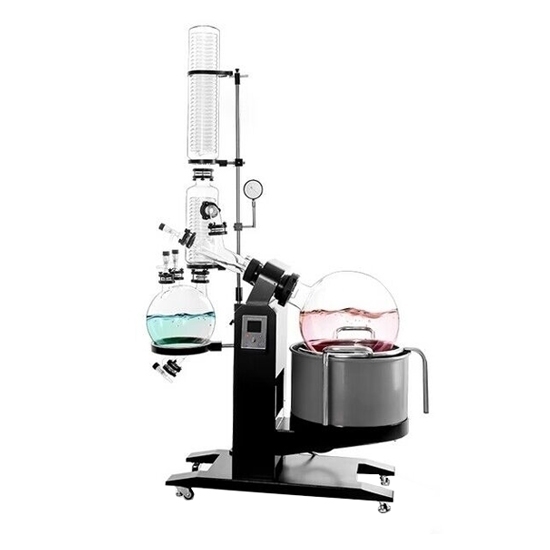
20L Rotary Vacuum Evaporator, 20-120 Rpm
from
$5,988.76
Ex Tax: $5,988.76
- Stock: In Stock
- Model: RDDLZ-RVE-20L
- Weight: 1.00
- SKU: RDDLZ-RVE-20L
Available Options
Create unlimited custom product blocks and display them in accordions or tabs or open blocks. Each block can be assigned to all products at once or specific products according to advanced criteria.
Create unlimited custom product blocks and display them in accordions or tabs or open blocks. Each block can be assigned to all products at once or specific products according to advanced criteria.
RDDLZ high efficiency rotary vacuum evaporator has a 250W motor and a 20L rotating bottle capacity. The brushless motor, heater, and electrical control box are all explosion-proof with a d II BT4 rating, which ensures a safe working environment for the operator and minimizes the risk of accidents.
Specification
| Model | RDDLZ-RE1020 |
| Rotating Bottle | 10L, F125MM |
| Collection Bottle | 5L, Lower feeding |
| Speed Mode | Digital display frequency conversion speed regulation |
| Rotating Motor Power | 250W |
| Host Speed | 20-120 rpm |
| Condensation Area | 1.0 m2 (main cooling), 0.4 m2 (secondary cooling) |
| Evaporation Rate | 5.0 L/h (water), 14.3L/h (ethanol) |
| Achieved Vacuum | <133 Pa (1 33mbar, 1Tor) |
| Bath Power | 5 kW |
| Condenser | Vertical, main cooling + auxiliary cooling, high-efficiency double return condenser |
| Temperature Control Range & Fluctuation | Room temperature -99 °C (200) ± 0.5 |
| Temperature Display Mode | Liquid crystal display |
| Bathtub | SUS304 material, φ450mm* 260mm |
| Lifting Function | Electric lift |
| Vacuum Connection Diameter | Outer diameter 12mm |
| Condensed Water Diameter | Outer diameter 15mm |
| Power Supply | 220V/50Hz |
| Dimension | 1120*680*1900mm |
| Weight | 125kg |
Features
- PTFE and fluororubber dual sealing ensure high vacuum degree.
- The exhaust nozzle of the condenser is positioned below for safer connection with the vacuum tube.
- The rotary vacuum evaporator has a modular design with strong scalability.
- Convenient lifting operation to avoid movement of the glass parts, ensuring safety and ease of use.
- The rotational speed and bath temperature are displayed digitally and controlled by PID for high temperature control accuracy.
- The bath is separated from the 20L rotary evaporator, allowing flexible configuration.
- The motor, heater, and electrical control box are all explosion-proof, and the explosion-proof grade is d II BT4.
Applications
Rotary evaporators are commonly used in laboratories and industries for efficient solvent evaporation and concentration processes, such as in pharmaceutical research, chemical synthesis, and essential oil extraction.
Tips: How does a rotary evaporator work?
The basic principle of a rotary evaporator involves the application of heat and reduced pressure to facilitate the evaporation of solvents. Here's a step-by-step explanation of how it works:
- Setup: The rotary evaporator consists of several components. The main components include a heating bath, a rotating flask, a condenser, and a vacuum system. The heating bath provides heat to the flask, which contains the sample or solution to be evaporated. The condenser is attached to the flask and cools the vapors to promote condensation. The vacuum system creates a reduced pressure environment to lower the boiling point of the solvents.
- Preparation: The sample or solution is placed in the rotating flask, which is then attached to the rotary evaporator. The flask is typically rotated to increase the surface area exposed to the heat and enhance the evaporation process.
- Evaporation: The heating bath is filled with a heat transfer fluid, such as water or oil, and heated to the desired temperature. The heat from the bath is transferred to the flask, causing the solvent to evaporate. The rotation of the flask helps to distribute the sample evenly and prevent bumping, where the liquid rapidly boils and splashes out of the flask.
- Condensation: As the solvent evaporates, the vapors rise up into the condenser. The condenser is typically cooled by circulating cold water or another coolant. The cool surface of the condenser causes the vapors to condense back into a liquid state, which drips down into a separate collection flask.
- Vacuum: A vacuum is applied to the system using a vacuum pump or aspirator. By reducing the pressure, the boiling point of the solvent is lowered, allowing for more efficient evaporation at lower temperatures. The vacuum also helps to remove the evaporated solvent vapor from the system, aiding in the separation process.
- Collection: The condensed solvent collects in the collection flask, separate from the remaining sample or solute. The evaporated solvent can be recovered and reused, while the remaining sample can be further processed or analyzed.
Builder in Product TAB
NEW! Since Journal 3.2, the much improved T.A.B (Tabs Accordion Blocks) system supports the page builder inside the tab content. Unlimited Blocks, Tabs or Accordions with any HTML content or the builder interface (supporting custom rows/columns/modules) can be assigned to any individual product or to certain groups of products, like entire categories, brands, products with specific options, attributes, price range, etc.
You can indicate any criteria via the advanced product assignment mechanism and only those products matching your criteria will display the modules.
Also, any module can be selectively activated per device (desktop/tablet/phone), customer login status and other criteria. Imagine the possibilities.
